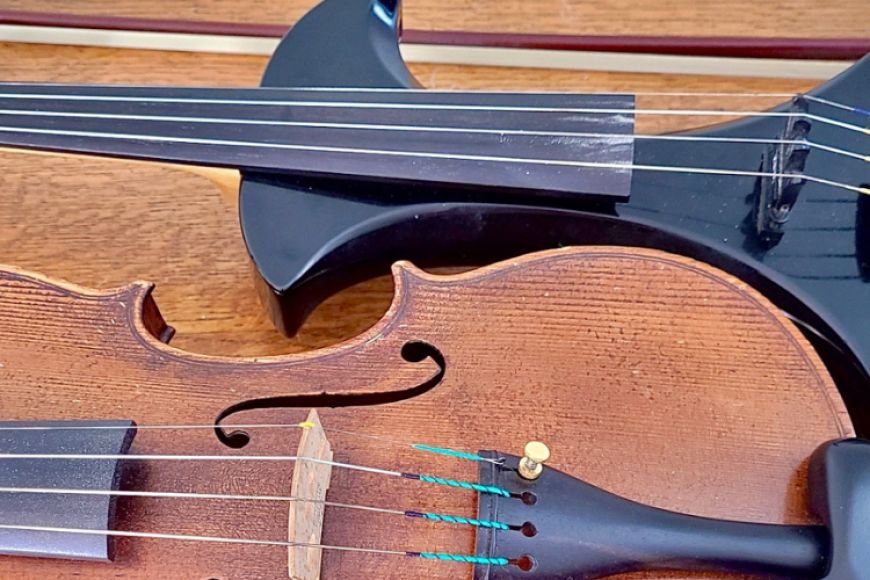Classical, Jazz, Celtic, Pop, Rock: The Violin Does it All

The violin has seen many innovations in playing styles since it was created in the 16th century. In fact, there is quite a long history of violinists finding ways to blend this instrument into genres beyond classical and traditional fiddle music.
Nowadays, universities are even offering degrees in what is typically known as “commercial” or “contemporary” string music. This essentially means you study and gain expertise in a wide range of styles including pop, rock, and jazz. Many major symphonies from all over the world have even started mixing adaptations of pop, hip-hop, and rock songs into their concerts.
I have loved many different styles of music ever since I was a kid. When I began playing violin, I listened and even tried to play songs from all genres. I would practice what my teacher had assigned me (usually songs from the Suzuki books and scales) and then take a break from that to try to figure out anything from Beatles tunes to video game soundtracks. Bottom line, I just loved playing music. By the time I reached high school I was pretty set on pursuing music as a career, and since violin was my main instrument I thought that meant getting a degree in classical music. It had not yet occurred to me that I could make a living playing other styles (this was before the days of YouTube where contemporary violinists could share their music and reach large audiences). Then one afternoon I received an invitation in the mail to play in an honor orchestra that would be featuring a jazz violinist. I remember thinking how cool that someone could play jazz on the violin! That moment completely changed how I thought of violin, and opened my eyes to a huge world of possibilities. A few months after the honor orchestra concert, I was extremely fortunate to be able to start taking lessons with that jazz violinist, Tracy Silverman. Tracy also performs a wide variety of genres and is known for his unique strum bowing style of playing. As I continued to study jazz and then ultimately other genres on violin, I began to do research and realized there was a rich history of violinists playing in many styles.
Some of the earliest known alternative violinists worked primarily in jazz.
This includes Peter Bocage, Eddie South, and Claude Williams, who were playing as soloists in swing bands during the early 1900s. There is also Ray Nance who was both a trumpeter and violinist with Duke Ellington’s band. Then of course there are Joe Venuti and Stéphane Grappelli who most people think of when it comes to jazz and violin. Ginger Smock is notable for being one of the first female jazz violinists known in history. Another famous name in jazz violin was Stuff Smith. He was featured on recordings with Nat King Cole and later became a sideman with Ella Fitzgerald and Dizzy Gillespie. One particularly interesting thing about Stuff Smith is that he is credited as being the first violinist to experiment with playing violin through an amplifier. In the 1960s, jazz violinist Jean-Luc Ponty kick-started his own long and fruitful solo career when he performed with the Modern Jazz Quartet at the Monterey Jazz Festival. Jean-Luc has also worked in the jazz-rock fusion genre, and appeared as a sideman with many artists including Chick Corea, Frank Zappa, and Elton John. These days, the jazz violin world continues to thrive and expand. You can check out music by Regina Carter and Scott Tixier to hear modern day examples.
Over the course of the early to mid-1900s, electric violins and pickups for acoustic violins were introduced into the world.
This allowed players to try even more styles of music since they could now be heard more easily over louder instruments such as drums and other amplified instruments. With these electrified instruments, new styles of violin playing emerged as rock and blues music evolved. Some players such as Papa John Creach and Sugarcane Harris, experimented with effects pedals that let them pursue a more Jimi Hendrix-like sound. Others like Jerry Goodman, Eddie Jobson, and Dave Arbus favored a sound that was more of a fusion of folk, fiddle, and rock elements. There are a handful of famous songs in the history of rock that feature violin solos. This includes “Dust in the Wind” by Kansas and “Baba O’Riley” by The Who. Lisa Germano is also a great example of a violinist who blended folk and rock styles into her playing. You can hear her on several John Mellencamp songs including “Check It Out” and “Paper in Fire.” Another major name in rock violin is Mark Wood. He was one of the original members of the Trans-Siberian Orchestra, and has performed with many famous artists including Billy Joel, Lenny Kravitz, and Kanye West. He is also well known as the creator of his own electric violin company, Wood Violins. More recent examples of rock and pop violinists include Sean Mackin from the band Yellowcard, and Andrew Bird.
These days there is a large community of contemporary violinists who are thriving as YouTubers and DIY musicians.
Lindsey Stirling is perhaps the most famous example. She performs a blend of her own original dubstep-inspired compositions as well as covers of popular songs. Taylor Davis is another violinist on YouTube and is known for performing music from movie and video game soundtracks as well as original compositions. Both players add the element of dressing in character for their music videos. There is also DSharp who covers an assortment of pop, rock, and hip-hop, and R&B songs in addition to his original compositions. Hip-hop violinist Miri Ben-Ari, who has collaborated with famous artists such as Alicia Keys, John Legend, and Jay-Z, can also be found on YouTube.
Throughout the years there have been violinists who have also added singing while they play in various ways. My teacher, Tracy Silverman, is one such player. He creates loop backgrounds with his strum bowing style and then sings over those. Andrew Bird is another violinist who often creates loops with his violin and then sings over those layers. Lili Haydn is another vocalist and violinist you can check out if you have an interest in singing while playing.
When it comes to playing genres outside of the long-established traditions of classical and fiddle, the sky is truly the limit.
The commercial/contemporary fields of string playing are continuing to grow and expand, and players are trying new things all the time. You can let creativity and inspiration take you almost anywhere with this instrument. Who knows, with practice, you may be the one to pioneer the next technique that creates new sounds and styles of violin playing. I encourage you to keep playing and exploring sounds.
 |
ABOUT CAITLIN CALVERT
Caitlin is a multi-instrumentalist and composer with 12 years of experience teaching and over 19 years of performing. She is passionate about helping students work toward their goals and loves to help them find their own style and musical expression. She has expertise in a diverse range of genres including classical, pop, Celtic, and jazz. |




